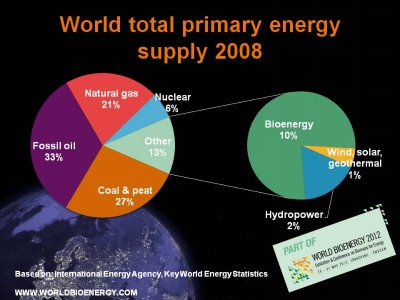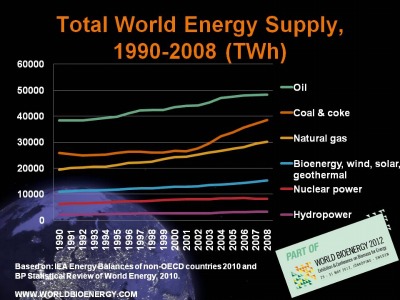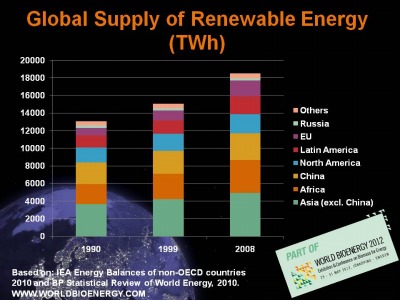
Global bioenergy almost 2x nuclear energy
June 21, 2011
By World Bioenergy Association
 |
June 21, 2011 – While fossil fuels still
dominate the global energy supply, with a combined share of 81%, renewable
energy sources have the potential to become the dominant sources of energy for
coming generations. Bioenergy is already about twice the magnitude of nuclear
energy worldwide.
Within the renewable energy sector,
bioenergy is the dominant source, followed by hydropower and to a smaller
extent wind, geothermal, and solar energy. Renewable energy in general, and
bioenergy in particular, also have great potential for increased use. According
to a position paper from the World Bioenergy Association, the potential for
bioenergy use worldwide in 2050 is estimated at 20 to 30 times the current use.
The world energy supply still depends on
the fossil fuels, with 33% oil, 27% coal and peat, and 21% natural gas. Nuclear
energy represents almost 6%. Renewable energy corresponds to 13% of the global
energy supply, comprising 10% bioenergy, 2% hydropower, and 1% wind, solar, and
geothermal energy.

|
|
| Based on: International Energy Agency, Key World Energy Statistics 2010. |
The total world energy supply has increased by 40% from 1990 to 2008, with a
relatively constant share of fossil energy at around 80%. The share of coal has
increased significantly the last decade.
To address problems arising from global
warming, a large-scale reduction in the supply and use of fossil fuels is
critical. Wide varieties of renewable energy sources, as well as more efficient
energy use both need to be adopted worldwide. A large share of coal-based
electricity production can potentially be converted to biomass. Combined heat and
power plants (CHP) that use surplus heat from the electricity production to
heat buildings or whole cities is one way of minimizing energy losses and
increasing energy efficiency. Biomass-based CHP is used successfully in many
Nordic cities.
For the first time since 1982, global
demand for energy actually decreased in 2009, especially within the OECD
countries. Oil demand is estimated to have decreased by 3% compared to 2008.
Coal demand decreased heavily in Europe and North America, but increased globally
by about 2%, mainly due to a large increase in China.

|
|
| Based on: IEA Energy Balances of non-OECD countries 2010 and BP Statistical Review of World Energy, 2010. |
The supply and use of renewable energy is
increasing and needs to increase strongly in the near future to replace
non-renewable energy sources used today. Since 1990, the worldwide supply of
renewable energy has increased by 42% from around 13,000 to almost 18,500 TWh
(1 TWh = 1 billion kWh) and now represents 13% of the total worldwide supply of
energy.
Asia is the dominant supplier of renewable
energy, followed by Africa and North America. The largest increase however is
seen in the EU, where renewable energy has more than doubled since 1990. Both
Africa and Latin America have increased their supply of renewable energy by
more than 50%.
 |
|
| Based on: IEA Energy Balances of non-OECD countries 2010 and BP Statistical Review of World Energy, 2010. |
Print this page